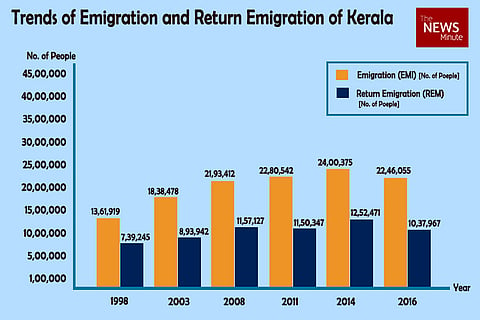

For decades Kerala and emigration have been virtually synonymous in the public imagination. But the trend may be showing signs of reversal according to the draft results of a survey by the Thiruvananthapuram-based Centre for Development Studies.
One of the most significant results of the survey is the fall in remittances from Rs 71,142 crore in 2014 to Rs 63,289 crore in 2016. As the graph below shows, this is a very important shift, as the remittance figure has always shown a strong upward trend since 1998, when the CDS migration surveys began.
Remittances refer to the money sent by migrants back home to their families.
What’s more, Professor Irudaya Rajan, who conducted the Kerala Migration Survey 2016, said that remittances are expected to decline by 10% every year.
Alongside the fall in remittances, the CDS survey has also found that the number of Keralites emigrating out of the country has shrunk from previous years for the first time. Thus, while 24,00,375 Keralites emigrated in 2014, only 22,46,055 people migrated in 2016. That is a massive reduction of nearly 1.5 lakh emigrants over the last two years.
Interestingly, the survey also showed that the number of people returning to Kerala has also fallen in the last two years. While 12,52,471 people returned in 2014, only 10,37,967 people came back last year.
Importantly, the drop in emigration is a statewide phenomenon, with eight of the 14 districts registering a drop in numbers from 2013 to 2016. Among these, Ernakulam showed the largest reduction of 75,335 migrants, followed by Malappuram and Pathanamthitta.
Of the six districts that showed continuing growth in the number of migrants, Kottayam recorded the highest increase of 47,780 migrants, followed by Thiruvananthapuram.
In terms of their destinations, the Gulf nations have continued to remain the overwhelming favourite for Keralites, with nearly 90% of emigrants heading there. Among these, the UAE drew the highest number of 40.3% of migrants, while Saudi Arabia came in second with 23.9%. Outside the Gulf region, the US drew the highest number with 4.2% of migrants.
Interestingly, there is a distinct gender distribution in the destinations chosen by migrants. Of course, the majority of men (92.3%) and women (71.1%) migrated to the Gulf nations. However, Australia, Canada, Singapore, the UK and the US all recorded higher percentages of women than men migrants. The US, for instance, saw 12.8% of women heading there, but only 2.7% of men.
Understanding these patterns
According to Rajan, there are two major shifts that are contributing to the shift in migration.
The first is that falling wage rates, thanks to factors like fall in crude oil prices and the influx of other groups of migrants, have made the Gulf region a less attractive option. Added to this is the fact that men in the 20-34 age bracket, which is the prime migration bracket, are less willing to take up unskilled, blue-collar jobs, Rajan told Mint. Educated women from the state have been moving out in larger proportions, but their numbers are still not anywhere as high as those of male migrants.
Rajan also told Scroll that the fall in numbers reflects changes in the population patterns in the state. Referring to the “migration-prone age group” of 20-34, Rajan said, “This group is shrinking in Kerala thanks to the low child birth rates. The majority of the parents in Kerala had opted for the two-children policy by the late 1990s. It has caused a human resource shortage.”